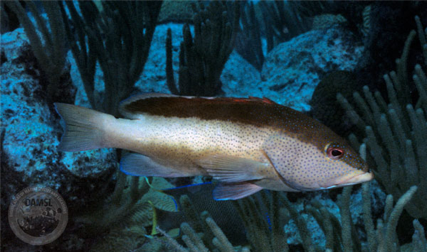Coney Information

Coney are a species of fish belonging to the family Serranidae. As a result, they are also part of the grouper family and strictly a marine fish. They inhabit only the western Atlantic Ocean from South Carolina to Bermuda, as well as south to southern Brazil. They are common to Florida, the Bahamas and Caribbean. Their preferred habit is deeper reefs in clear water. They can be found anywhere from 2 to 150 meters deep, but occur commonly at 35 meter depths. For example, coney have been spotted in high visibility conditions on deep reefs of at least 45 meters in the Gulf of Mexico. Places like Bermuda and the West Indies though show coney living in more shallow waters. Coney will hide in caves and under ledges during the day and hunt at night. Their food is drawn in by the powerful suction from their mouths and swallowed whole. They are carnivorous and feed on small fish and invertebrates.
Their bodies are elongated with a curved profile. They have large, round eyes and a pointed snout. Their large mouth contains thousands of small rasp-like teeth that cover the jaw. Coney go through numerous color phases. They have a full reddish brown phase, a bicolor phase with a darker top of usually orange, red or tan over a white bottom, and a full bright yellow phase. They all have mild to intense amounts of speckles on the body. These speckles are sometimes blue in color. Usually the largest a coney will grow is 16 inches in length.
Coney are protogynous, meaning they mature first as females and then becomes males later on. Female maturity is reached usually around 16 cm in length, and they usually don’t change into males until around at least 20 cm in length. The males are confirmed as territorial. In the wild, these fish are usually wary of divers but still approachable. They’re very abundant in their range of habitat, which is probably why the IUCN (International Union for Conservation of Nature) lists them as a species of least concern. They are consumed by humans, but only sold at local markets where they are caught nearby. Coneys have been reported to cause ciguatera poisoning though, so caution should be taken.
